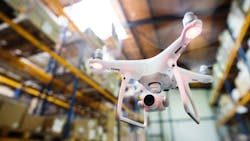Robots redefine inventory tracking and material handling
Key takeaways
- AI-powered drones automate inventory in dark, cold warehouses, boosting accuracy and reducing manual labor.
- AMRs with buffer management streamline material staging, improving workflow efficiency and labor allocation.
- Robotic picking systems increase warehouse throughput and cut costs by coordinating workers and AMRs in real time.
- New vacuum grippers and heavy-lift robots handle demanding payloads, enhancing flexibility in palletizing and assembly tasks.
Robotic automation solutions for manufacturers, warehouses, and distribution centers deliver precision, efficiency, and power where it is needed most. New and improved solutions tackle today’s industry challenges, and a novel technology toolkit facilitates the development of AI-powered robotic applications.
Next-gen robotics driving smarter warehouse and inventory operations
Flying robots help to automate processes such as warehouse inventory audits. The Corvus One Autonomous Inventory Management System from Corvus Robotics is a drone system that scans barcodes, counts cases, and identifies stockouts, even in lights-out environments. Key enablers include computer vision and a proprietary AI large world model (LWM) that provides a learning-based approach to autonomy. Integration of SwiftDecoder barcode-decoding software from Honeywell accelerates inventory counting at the case- and pallet-level by capturing many barcodes at the same time.
"The latest version of Corvus One can now autonomously operate in total darkness, fly in aisles as narrow as 50 inches, and count cases automatically,” says Corvus Robotics CEO Jackie Wu. “Built to handle the cold, Corvus One works reliably in chilled environments down to 34°F, giving warehouses and distribution centers hands-free, accurate inventory tracking in virtually any warehouse condition."
The new Autonomous Buffer Management (ABM) solution from Seegrid supports end-to-end material handling automation. The manufacturer of autonomous mobile robots (AMR) for palletized material handling developed ABM to optimize buffer management with its Lift AMR solutions, improving efficiency and predictability.
Seegrid CTO Tom Panzarella explains that buffers are essentially a collection of discrete material staging locations organized in a particular way. “Our technology gives modern manufacturers the flexibility to optimize staging and storage with precision, reducing bottlenecks and maximizing operational efficiency. With seamless integration into existing workflows, it empowers facilities to focus their available manual labor on higher-value tasks while automation handles the rest,” he adds.
Zebra Symmetry Fulfillment from Zebra Technologies is an AMR-assisted picking technology designed to enhance warehouse operations. It combines the company’s new Zebra Connect Fulfillment AMRs, wearable technologies, software, and analytics to increase productivity and throughput while reducing costs.
“Powered by Team Intelligence, Zebra Symmetry Fulfillment coordinates workers and robots in a precise workflow, allowing pickers to handle more items faster,” observes Matthew Wicks, VP of robotics automation at Zebra Technologies. “Detachable carts with larger capacity support a broader range of product sizes and up to 300% more volume, increasing pick density and eliminating AMR wait times. Decoupling AMRs from carts at key points lets robots return to picking tasks immediately, reducing the number of robots needed by up to 30%.”
High-performance robotic grippers and heavy-duty automation for material handling
For robust palletizing and material handling applications, the new VGP30 from OnRobot is the company’s most powerful vacuum gripper to date. It is engineered to handle payloads of up to 30kg while offering the flexibility to grip one or two boxes, even off-center. Collaborative applications benefit from a low noise level of 59 dB(A). An optional continuous monitoring feature provides real-time feedback on air flow.
“Unlike our electric grippers, the VGP30 is air-driven and intelligently regulates vacuum levels to reduce compressed air consumption and overall operating costs. What truly sets it apart is its seamless integration into OnRobot’s unified platform, delivering advanced performance without the complexity typically seen in traditional pneumatic solutions,” says Jesper Fuglsig, R&D director at OnRobot.
The M-950iA/500 from Fanuc America is a new heavyweight industrial robot designed to handle payloads up to 500 kg with flexibility and adaptability to tight workspaces. Its serial-link design offers a wider range of motion than standard parallel-link robots, including the ability to flip over backwards.
The robot’s long 2,830mm reach and powerful wrist enable large and heavy part lifting, palletizing, and similarly demanding material handling tasks. An optional accuracy and stiffness enhancement for the M-950iA ensures precision under external forces, making it suitable for applications such as friction stir welding, drilling, and riveting.
AI toolkits for collaborative robots accelerate deployment and boost production intelligence
AI Accelerator from Universal Robots (UR), designed in collaboration with NVIDIA, is a toolkit that offers developers of UR collaborative robot (i.e., cobot) solutions a full go-to-market architecture straight out of the box. It enables features such as pose estimation, tracking, object detection, path planning, image classification, quality inspection, and state detection.
The toolkit “significantly decreases deployment time and de-risks the development of AI-based robotic solutions. A case in point was the recent NVIDIA GTC conference where five robotics companies showcased new AI-powered applications developed in record time – some of them in just a couple of weeks – using the AI Accelerator,” notes Anders Beck, VP of innovation and strategy at Universal Robots.
About the Author

Sheila Kennedy
CMRP
Sheila Kennedy, CMRP, is a professional freelance writer specializing in industrial and technical topics. She established Additive Communications in 2003 to serve software, technology, and service providers in industries such as manufacturing and utilities, and became a contributing editor and Technology Toolbox columnist for Plant Services in 2004. Prior to Additive Communications, she had 11 years of experience implementing industrial information systems. Kennedy earned her B.S. at Purdue University and her MBA at the University of Phoenix. She can be reached at [email protected] or www.linkedin.com/in/kennedysheila.
